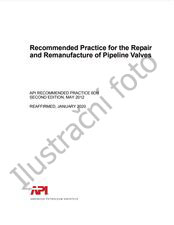Potřebujeme váš souhlas k využití jednotlivých dat, aby se vám mimo jiné mohly ukazovat informace týkající se vašich zájmů. Souhlas udělíte kliknutím na tlačítko „OK“.

API RP 17V-ed.1
Recommended Practice for Analysis, Design, Installation, and Testing of Safety Systems for Subsea Applications
Přeložit název
NORMA vydána dne 1.6.2020
Informace o normě:
Označení normy: API RP 17V-ed.1
Datum vydání normy: 1.6.2020
Kód zboží: NS-1140050
Počet stran: 74
Přibližná hmotnost: 222 g (0.49 liber)
Země: Americká technická norma
Kategorie: Technické normy API
Anotace textu normy API RP 17V-ed.1 :
API RP 17V, 1st Edition, February 2015 - Recommended Practice for Analysis, Design, Installation, and Testing of Safety Systems for Subsea Applications
General
This recommended practice (RP) presents recommendations for designing, installing, and testing a process safety system for subsea applications. The basic concepts of subsea safety systems are discussed and protection methods and requirements of the system are outlined.
For the purposes of this RP, ‘subsea system’ includes all process components from the wellhead (and surface controlled subsurface safety valve [SCSSV]) to upstream of the boarding shutdown valve. For gas injection, water injection, and gas lift systems, the shutdown valve is within the scope of API 17V. This also includes the chemical injection system.
This document is a companion document to API 14C, which provides guidance for topsides safety systems on offshore production facilities. Some sections of this document refer to API 14C for safety system methodology and processes. This RP illustrates how system analysis methods can be used to determine safety requirements to protect any process component. Actual analyses of the principal components are developed in such a manner that the requirements determined will be applicable whenever the component is used in the process. The safety requirements of the individual process components may then be integrated into a complete subsea safety system. The analysis procedures include a method to document and verify system integrity. The uniform method of identifying and symbolizing safety devices is presented in API 14C and adopted in this RP.
Subsea systems within the scope of this document include:
- — subsea trees (production and injection), flowlines, and SCSSVs;
- — chemical injection lines;
- — manifolds;
- — subsea separation;
- — subsea boosting;
- — subsea compression;
- — flowlines;
- — gas lift;
- — high integrity pressure protection system (HIPPS);
- — subsea isolation valves;
- — risers;
- — hydraulic power unit.
The safety system includes valves and flow control devices in the production system. The safety system also includes sensors installed in the production system to detect abnormal conditions and allow corrective action to be taken (whether manual or automatic).
The intention is to design subsea safety systems to meet the requirements of IEC 61511; this document supplements these requirements.
Procedures for testing common safety devices are presented with recommendations for test data, test frequency, and acceptable test tolerances.
Instrumentation logic circuits are not discussed since these should be left to the discretion of the designer as long as the recommended safety functions are accomplished. Rotating machinery is considered in this RP as a unitized process component as it interfaces with the subsea safety system. When rotating machinery (such as a pump or compressor) is installed as a unit consisting of several process components, each component may be analyzed as prescribed in this RP.
Organization of Technical Content
The technical content of this RP is arranged as follows:
Section 2: Provides a listing of the normative references relating to this RP.
Section 3: A compilation of terms, definitions, acronyms, and symbols used throughout this document, including recommended standard symbols and abbreviations for safety device and process component identification.
Section 4: The general purpose, functional requirements, and basic premises of subsea safety system analysis and design.
Section 5: A detailed discussion of recommended safety analysis techniques, the concepts of protection from which they were developed, and a step-by-step procedure for analyzing and establishing design criteria for a subsea safety system.
Annex A: A safety analysis for each process component commonly used in a production process, including a checklist of additional criteria that should be considered when the component is used in a specific process configuration.
Annex B: A discussion of supporting systems that perform specific safety functions common to the entire facility.
Annex C: Testing procedures and reporting methods for the accumulation of safety system test data that can be used for operational analysis and reports that may be required by regulatory agencies.
Government Codes, Rules, and Regulations
Regulatory agencies have established certain requirements for the design, installation, and operation of offshore production facilities. In addition to federal regulations, certain state and local regulations may be applicable.
In addition to the regulations listed in API 14C, the following federal documents pertain to offshore oil and gas producing operations and should be used when applicable:
- — 30 Code of Federal Regulations Part 250, Subpart H (Oil and Gas Sulphur Operations in the OCS) and Subpart J (Pipelines and Pipeline Right-of-Ways);
- — 40 Code of Federal Regulations Part 112, Chapter I, Subchapter D (Oil Pollution Prevention).



 Cookies
Cookies
